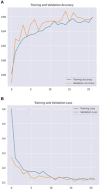Enhancing healthcare recommendation: transfer learning in deep convolutional neural networks for Alzheimer disease detection
- PMID: 39371344
- PMCID: PMC11451042
- DOI: 10.3389/fmed.2024.1445325
Enhancing healthcare recommendation: transfer learning in deep convolutional neural networks for Alzheimer disease detection
Abstract
Neurodegenerative disorders such as Alzheimer's Disease (AD) and Mild Cognitive Impairment (MCI) significantly impact brain function and cognition. Advanced neuroimaging techniques, particularly Magnetic Resonance Imaging (MRI), play a crucial role in diagnosing these conditions by detecting structural abnormalities. This study leverages the ADNI and OASIS datasets, renowned for their extensive MRI data, to develop effective models for detecting AD and MCI. The research conducted three sets of tests, comparing multiple groups: multi-class classification (AD vs. Cognitively Normal (CN) vs. MCI), binary classification (AD vs. CN, and MCI vs. CN), to evaluate the performance of models trained on ADNI and OASIS datasets. Key preprocessing techniques such as Gaussian filtering, contrast enhancement, and resizing were applied to both datasets. Additionally, skull stripping using U-Net was utilized to extract features by removing the skull. Several prominent deep learning architectures including DenseNet-201, EfficientNet-B0, ResNet-50, ResNet-101, and ResNet-152 were investigated to identify subtle patterns associated with AD and MCI. Transfer learning techniques were employed to enhance model performance, leveraging pre-trained datasets for improved Alzheimer's MCI detection. ResNet-101 exhibited superior performance compared to other models, achieving 98.21% accuracy on the ADNI dataset and 97.45% accuracy on the OASIS dataset in multi-class classification tasks encompassing AD, CN, and MCI. It also performed well in binary classification tasks distinguishing AD from CN. ResNet-152 excelled particularly in binary classification between MCI and CN on the OASIS dataset. These findings underscore the utility of deep learning models in accurately identifying and distinguishing neurodegenerative diseases, showcasing their potential for enhancing clinical diagnosis and treatment monitoring.
Keywords: Densenet; EfficientNet-B0; Resnet; clustering; decision making; deep learning; healthcare; skull stripping.
Copyright © 2024 Pandey, Pruthi, Alzahrani, Verma and Zohra.
Conflict of interest statement
The authors declare that the research was conducted in the absence of any commercial or financial relationships that could be construed as a potential conflict of interest.
Figures








References
-
- What is mild cognitive impairment? Available at: https://www.nia.nih.gov/health/memory-loss-and-forgetfulness/what-mild-c.... November 22, 2023.
-
- ADNI . Alzheimer’s Disease Neuroimaging Initiative. Available at: https://adni.loni.usc.edu/. February 20, 2023.
Grants and funding
LinkOut - more resources
Full Text Sources

